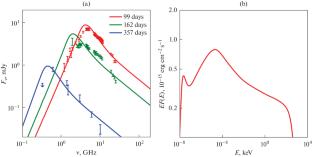Can Fast Blue Optical Transients be Cosmic Pevatrons?
IF 0.48
Q4 Physics and Astronomy
Bulletin of the Russian Academy of Sciences: Physics
Pub Date : 2025-07-15
DOI:10.1134/S1062873825711547
引用次数: 0
Abstract
The new class of recently discovered astrophysical objects—fast blue optical transients (FBOT) demonstrated a high luminosity of radio and X-ray radiation and the expansion velocities above 0.1 c over a year time scale. They are likely sub-class of core-collapse supernova events. We present here results of modeling of particle acceleration in mildly-relativistic shocks associated with FBOTs. It is shown, that objects with mildly-relativistic shocks can be possible sources of particles with energies above 1 PeV, and emit detectable fluxes of hard X-ray radiation.

快速蓝光瞬态能成为宇宙涡旋吗?
最近发现的一类新的天体物理对象-快速蓝光瞬变(FBOT)显示出高亮度的射电和x射线辐射以及在一年时间尺度上超过0.1 c的膨胀速度。它们很可能是核心坍缩超新星事件的子类。我们在此展示了与FBOTs相关的温和相对论性冲击中粒子加速度的建模结果。结果表明,具有轻微相对论性冲击的物体可能是能量超过1 PeV的粒子的可能来源,并发射可探测的硬x射线辐射通量。
本文章由计算机程序翻译,如有差异,请以英文原文为准。
求助全文
约1分钟内获得全文
求助全文
来源期刊

Bulletin of the Russian Academy of Sciences: Physics
Physics and Astronomy-Physics and Astronomy (all)
CiteScore
0.90
自引率
0.00%
发文量
251
期刊介绍:
Bulletin of the Russian Academy of Sciences: Physics is an international peer reviewed journal published with the participation of the Russian Academy of Sciences. It presents full-text articles (regular, letters to the editor, reviews) with the most recent results in miscellaneous fields of physics and astronomy: nuclear physics, cosmic rays, condensed matter physics, plasma physics, optics and photonics, nanotechnologies, solar and astrophysics, physical applications in material sciences, life sciences, etc. Bulletin of the Russian Academy of Sciences: Physics focuses on the most relevant multidisciplinary topics in natural sciences, both fundamental and applied. Manuscripts can be submitted in Russian and English languages and are subject to peer review. Accepted articles are usually combined in thematic issues on certain topics according to the journal editorial policy. Authors featured in the journal represent renowned scientific laboratories and institutes from different countries, including large international collaborations. There are globally recognized researchers among the authors: Nobel laureates and recipients of other awards, and members of national academies of sciences and international scientific societies.
 求助内容:
求助内容: 应助结果提醒方式:
应助结果提醒方式:


